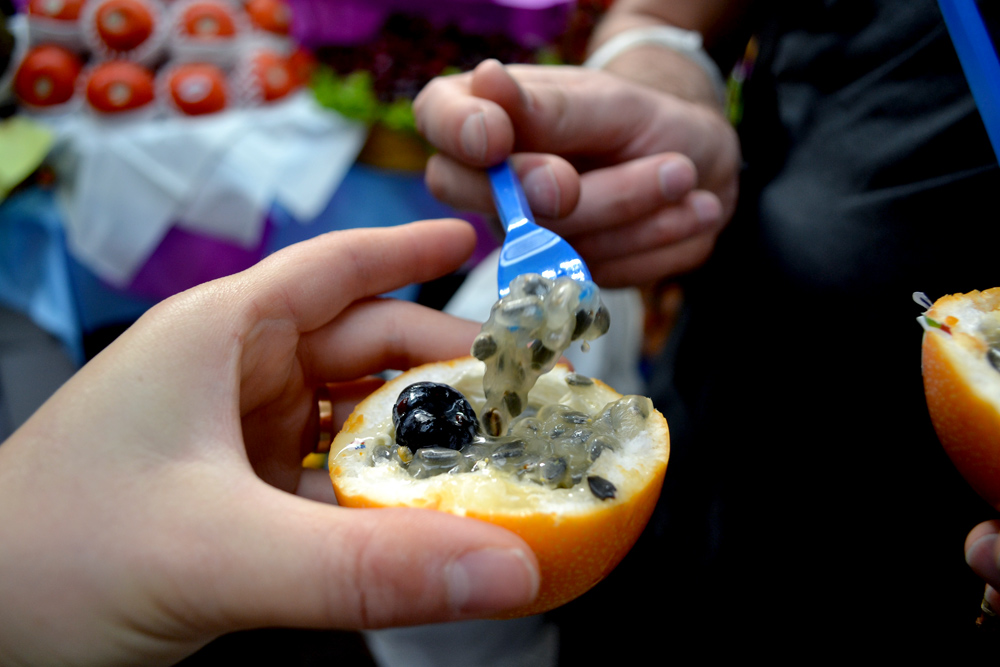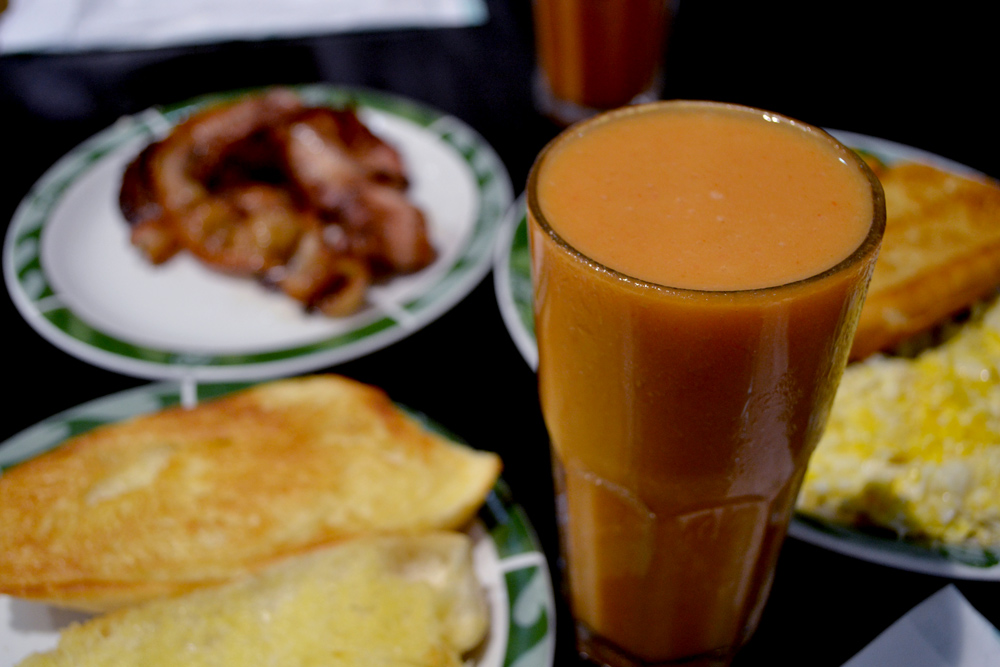
Spending two weeks in Brazil the middle of the Umami Mart
build-out was a bit disorienting. But the abundance of tropical fruits on street stalls, in the grocery store and in fancy restaurants forced me forget about home and embrace the fact that I was living amongst wild coconut trees and bossa nova.
As a fruit fiend, I am always on the lookout for fruit. My fruit find in Brazil didn't take much searching.
Maracuja (passion fruit) is everywhere. In California, I sometimes see passion fruit-flavored candy or juice, but it's definitely not as in-your-face as it is in Brazil.
Fresh off the plane,
Super Faminto columinist Bryan took me to a farmer's market in the São Paulo neighborhood Paraiso. We went straight to a fruit stall where they cut everything for us to try in front of our eyes.
 Maracuja at Mercado Municipal in Sao Paolo
Maracuja at Mercado Municipal in Sao Paolo
I fell in love with the tangy, soda-like flavor of the passion fruit seeds. And both the fruit vendor and Bryan were tutoring my gringo-ass exclaiming, "No chewing, just swallow the seeds!" The slimy, cool texture of the seeds were so rejuvenating after an exhausting 16-hour trip.

After my love-at-first-site moment with
maracuja, I set out to try as many passion fruit things as possible.
There's no reason why your day can't begin with some passion fruit juice. This was tart and thick, like a natural sweet tart! A great accompaniment to some bread and butter.

Then you can also end your day with passion fruit cocktails:
 Left is a traditional caipirinha; right is a passion fruit caipirinha. At Dalva e Dito in São Paolo.
Left is a traditional caipirinha; right is a passion fruit caipirinha. At Dalva e Dito in São Paolo.
One of the greatest powers of sounds and flavors is that they can really take you back to a time and place. After my many passion fruit experiences in Brazil, breaking one open will remind me of all the bus rides, volleyball players and sounds during my time there.
While bananas are my work fruit, cherries are my dessert fruit and
nashi (pears) are my hot-day fruit --
maracuja is my official vacation fruit.
 Spending two weeks in Brazil the middle of the Umami Mart build-out was a bit disorienting. But the abundance of tropical fruits on street stalls, in the grocery store and in fancy restaurants forced me forget about home and embrace the fact that I was living amongst wild coconut trees and bossa nova.
As a fruit fiend, I am always on the lookout for fruit. My fruit find in Brazil didn't take much searching. Maracuja (passion fruit) is everywhere. In California, I sometimes see passion fruit-flavored candy or juice, but it's definitely not as in-your-face as it is in Brazil.
Fresh off the plane, Super Faminto columinist Bryan took me to a farmer's market in the São Paulo neighborhood Paraiso. We went straight to a fruit stall where they cut everything for us to try in front of our eyes.
Spending two weeks in Brazil the middle of the Umami Mart build-out was a bit disorienting. But the abundance of tropical fruits on street stalls, in the grocery store and in fancy restaurants forced me forget about home and embrace the fact that I was living amongst wild coconut trees and bossa nova.
As a fruit fiend, I am always on the lookout for fruit. My fruit find in Brazil didn't take much searching. Maracuja (passion fruit) is everywhere. In California, I sometimes see passion fruit-flavored candy or juice, but it's definitely not as in-your-face as it is in Brazil.
Fresh off the plane, Super Faminto columinist Bryan took me to a farmer's market in the São Paulo neighborhood Paraiso. We went straight to a fruit stall where they cut everything for us to try in front of our eyes.
 Maracuja at Mercado Municipal in Sao Paolo
I fell in love with the tangy, soda-like flavor of the passion fruit seeds. And both the fruit vendor and Bryan were tutoring my gringo-ass exclaiming, "No chewing, just swallow the seeds!" The slimy, cool texture of the seeds were so rejuvenating after an exhausting 16-hour trip.
Maracuja at Mercado Municipal in Sao Paolo
I fell in love with the tangy, soda-like flavor of the passion fruit seeds. And both the fruit vendor and Bryan were tutoring my gringo-ass exclaiming, "No chewing, just swallow the seeds!" The slimy, cool texture of the seeds were so rejuvenating after an exhausting 16-hour trip.
 After my love-at-first-site moment with maracuja, I set out to try as many passion fruit things as possible.
There's no reason why your day can't begin with some passion fruit juice. This was tart and thick, like a natural sweet tart! A great accompaniment to some bread and butter.
After my love-at-first-site moment with maracuja, I set out to try as many passion fruit things as possible.
There's no reason why your day can't begin with some passion fruit juice. This was tart and thick, like a natural sweet tart! A great accompaniment to some bread and butter.
 Then you can also end your day with passion fruit cocktails:
Then you can also end your day with passion fruit cocktails:
 Left is a traditional caipirinha; right is a passion fruit caipirinha. At Dalva e Dito in São Paolo.
One of the greatest powers of sounds and flavors is that they can really take you back to a time and place. After my many passion fruit experiences in Brazil, breaking one open will remind me of all the bus rides, volleyball players and sounds during my time there.
While bananas are my work fruit, cherries are my dessert fruit and nashi (pears) are my hot-day fruit -- maracuja is my official vacation fruit.
Left is a traditional caipirinha; right is a passion fruit caipirinha. At Dalva e Dito in São Paolo.
One of the greatest powers of sounds and flavors is that they can really take you back to a time and place. After my many passion fruit experiences in Brazil, breaking one open will remind me of all the bus rides, volleyball players and sounds during my time there.
While bananas are my work fruit, cherries are my dessert fruit and nashi (pears) are my hot-day fruit -- maracuja is my official vacation fruit.




Comments (3)
Love the post on maracuja. We have a number of names for it in Spanish. In Puerto Rico we call it Parcha, in Nicaragua its called maracuya or calala, with an accent on the last a. Some places also call it Grenadilla (like a grenade, with its many segments holding seeds) Some of like to eat them raw. We also make aguas frescas, popsicles (paletas), sorbets, and of course cocktails! I learned it is called passionfruit because it flowers near Easter, the petals representing the 5 wounds of Christ and the stamen representing the Holy Trinity. Who knew!
BTW they grown in the Bay Area, though the only kind of fruit I have seen here is soft, and not hard shelled. The inside seeds can be yellow, orange, or white, like the variety you show from the farmers’ market. The flowers are very beautiful and can be white, red, peach colored, etc.
http://en.wikipedia.org/wiki/Passiflora_edulis Thank you for sharing!
Hi Laura,
Thanks for reading my post about maracuja! Wow, the background on why it is called passion fruit is very interesting. Yes, I have seen smaller passion fruit types with beady black seeds. Have you ever tried eating the types in the Bay Area?
Just found & enjoying this blog – and am making a list of things to try.
Here in Australia, passionfruit is highly popular – in all the shops & grown inmany back yards. It is used for cakes, icing, passionfruit butter, on pavlovas, ice cream, and anything else – fresh is of course best. The seeds/pulp freeze really well if you get your hands on a lot & want to save it.